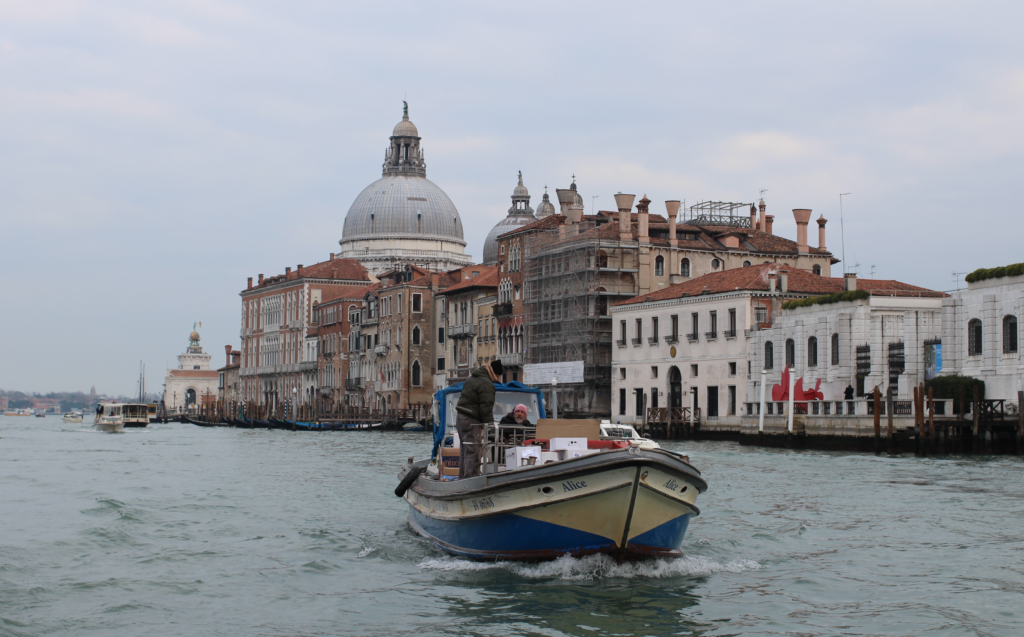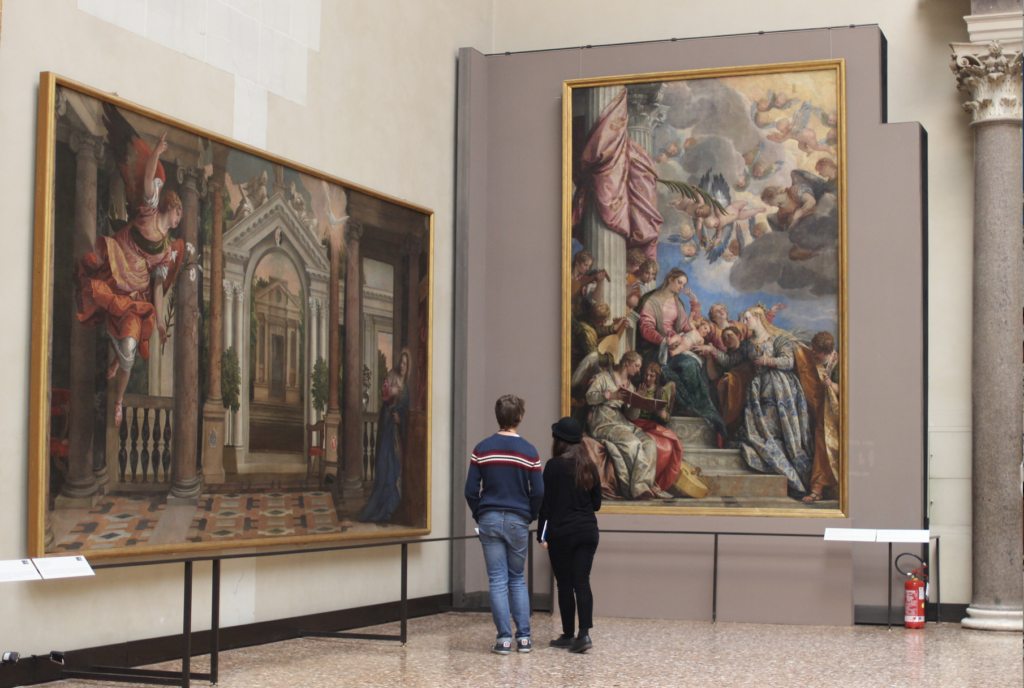Venice
Views of Venice
St Mark’s Square, St Mark’s Basin, and the Grand Canal.

View across St Mark’s Basin Palazzo Ducale
Palazzo Ducale

Piazza San Marco looking towards San Giorgio Maggiore

On the Grand Canal with Santa Maria della Salute in the distance
The Ca’ d’Oro Palace

Ca’ d’Oro Palace: Venetian Gothic tracery
La Fenice opera house
The Venetian opera house, La Fenice, is one of the finest in the world and has famously burnt down twice in recent years. However in 2005, it was been restored to its former glory and today is looking magnificent both on the inside and out.

La Fenice: main entrance

La Fenice: the auditorium
Fondazione Querini Stampalia
The Querini Stampalia is a museum devoted to life in 18th century Venice and contains a range of periods paintings, sculpture, porcelain and furniture. Below is the music room showing instruments ranging from violins and flutes to oboes and early piano. On the walls can be seen paintings by Pietro Longhi – the Hogarth of Venice – showing scenes of city life.

Querini Stampalia Museum: the music room

Querini Stampalia Museum: Bust of a Boy by Michele Fabris
Ospedale della Pietà
The Ospedale della Pietà (one of four charitable institutions fin Venice or orphans and abandoned children) was the foundation with which Vivaldi had a lifetime connection (1703 -1739) and it was for them that the bulk of his concertos and religious music was written. The musical standard reached in the Pietà Chapel – and those of the other Ospedali – was so great, that large congregations were attracted to them in order to hear the choirs and instrumentalists perform, especially in Lent, when music in other churches tended to be less elaborate. Peter has given countless organ recitals here in the chapel.

Ospedale della Pietà: façade of the church
Ospedale della Pietà: the museum

Ospedale della Pietà: double bass in the museum collection
Ospedale della Pietà: the organ gallery in the church
Ospedale della Pietà: the organ
St Mark’s at night
St Mark’s has over 4,000 square metres of gleaming golden mosaics, the earliest dating from the 12th century.

St Mark’s at night

St Mark’s: looking towards the apse above the high altar

St Mark’s: the crossing

St Mark’s: the tomb of St Mark

St Mark’s: a fresco in the crypt

St Mark’s: the crypt
San Martino
The church of San Martino (built between 1540 and 1619 by Jacopo Sansovino) is tucked away in one of the back streets of Venice. Vivaldi is known to have played the organ here.

San Martino: the nave looking back to the organ gallery

San Martino: the organ
Places seen on our walks through the city

Chiesa di Santa Maria dei Miracoli

Chiesa di Santa Maria dei Miracoli

Scuola Grande di San Marco

Scuola Grande di San Marco: St Mark’s lion on the façade

St Mark’s Clock, St Mark’s Square. The first clock housed in the tower was built and installed by Gian Paolo and Gian Carlo Rainieri, father and son, between 1496 and 1499. It has had many restorations over the centuries, the last one in 2006.

Chiesa di Santa Maria dei Derelitti: the façade
San Giovanni in Bragora
Vivaldi was baptised in the church of San Giovanni in Bragora in 1678 and an entry in the baptismal register records the event.

San Giovanni in Bragora: Peter will give an organ recital here

San Giovanni in Bragora: the chamber organ which Peter has played many times over the years

San Giovanni in Bragora: entry of Vivaldi’s name in the baptismal register of the church
Galleria dell’Accademia
The Gallerie dell’Accademia displays pre 19th century art in Venice and is housed in the Scuola della Carità on the south bank of the Grand Canal.

Gallerie dell’Accademia: Giovanni Bellini – Madonna with Child, musical angels, St Francis, John the Baptist, and St Sebastian

Gallerie dell’Accademia: Giovanni Bellini – detail of crumhorn playing angel

Gallerie dell’Accademia: paintings by Veronese
Annunciation (left) and Mystical Marriage of St Catherine (right)

Gallerie dell’Accademia: Pietro Longhi – A musical Party
A day visiting the islands
The islands of Venice include Isola di San Michele (Venice’s cemetery, where lie the graves of Diaghilev, Stravinsky, Luigi Nono and Ezra Pound), Torcello, Murano and Burano.

The coloured houses on the island of Burano. The composer Baldesaro Galuppi was born on the island in 1706 and in the market square is a statue commemorating Burano’s great son.

Burano: statue of Baldesaro Galuppi in the market square

Isola di San Michele: grave of Diaghilev

Torcello: Following the fall of the Western Roman Empire, Torcello was the first lagoon island to be populated. However, in the ensuing centuries the inhabitants battled against malaria-carrying mosquitos and by the late 14th century most people had removed themselves to Venice proper and other nearby islands. Today it has a population of 10 official inhabitants.

Torcello: mosaics in the Cathedral of Santa Maria Assunta

Torcello

Torcello: setting sun over the lagoon

The Lagoon: returning to Venice from Burano




![The Scotish [sic] Gigg](https://petermedhurst.com/wp-content/uploads/2012/08/Peter120813untitled-shoot-2.jpg)